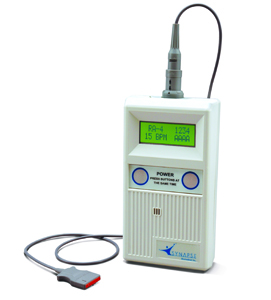
Plugging in A surgeon plugs the electrodes of the NeuRX DPS into the diaphragm using a special light-guide microscope called a laproscope. Image: University of Florida.
Breathing is essential to life. But for many people with ALS, breathing can be difficult to do.
In 2005, Case Western University School of Medicine’s Ray Onders MD introduced the NeuRX diaphragm pacing system (DPS) in hopes to help people with ALS breathe better. The electrical device, originally developed for people with spinal cord injuries, aims to help keep the diaphragm moving longer by boosting the stamina of these respiratory muscles.
The treatment strategy, FDA-approved for humanitarian use in 2011, might help slow respiratory decline and boost survival according to clinical studies. But a growing group of neurologists say more studies are needed to demonstrate that diaphragm pacing is an effective treatment for people with ALS.
Now, a US team led by State University of New York’s Kirsten Gruis MD hopes to clear the air by putting the NeuRX DPS to the test in a randomized controlled clinical trial. The study is expected to help clinicians best meet the respiratory needs of people with ALS.
”ALS clinicians would really like to have more information,” says Gruis, “to know whether to recommend this therapy to their patients.”
The phase II clinical trial is expected to begin in the summer of 2013.
Case Western School of Medicine's Ray Onders MD implanted the first diaphragm pacer into a person with ALS in March 2005. Nearly a decade later, however, neurologists remain unsure whether to recommend the treatment strategy to their patients.

Resetting the pace? The diaphragm pacer aims to boost the stamina of the diaphragm by electrically conditioning these breathing muscles. Image: Synapse Biomedical.
One of the biggest concerns according to California Pacific Medical Center's Jonathan Katz MD is whether healthier people with ALS are in some way being selected for the procedure. People who would live longer with the disease – with or without the device.
”We have to do a randomized trial,” says Katz, co-principal investigator of the study. “There is still an open question whether the procedure works.”
Many neurologists simply do not know whether to recommend diaphragm pacing. A decision that is all the more difficult due to the growing number of clinical trials of emerging ALS medicines that excludes patients that use them.
Now, a US team is gearing up to put the NeuRX DPS through its paces in people with ALS. Clinicians will compare the breathing abilities, quality of life and survival rates of people with ALS using the NeuRX DPS to those being treated by the standard of care alone (non-invasive ventilation).
The clinical trial, run by the Northeast ALS (NEALS) Consortium and Western ALS (WALS) study group, will take place at 20 ALS clinics in North America. Sites include the State University of New York’s Upstate Medical University in Albany and California Pacific Medical Center in San Francisco. 180 people with ALS are expected to participate.
The results will help clinicians determine whether diaphragm pacing is effective and identify certain subsets of people with ALS most likely to benefit from the procedure.
"For the first time in the history of ALS, we have an intervention that is possibly very powerful. But we don't have the evidence we would like to have supporting its use," says Duke University School of Medicine's Rick Bedlack MD. "It is critically important for us to confirm that it really does work."
***
To learn more about the NeuRX DPS including the upcoming clinical trial, tune into our podcast with Kirsten Gruis MD, DPS Point Blank.
References
Onders, R.P., et al. (2009) Complete worldwide operative experience in laparoscopic diaphragm pacing: results and differences in spinal cord injured patients and amyotrophic lateral sclerosis patients. Surgical Endoscopy, 23(7), 1433-1440. Abstract | Full Text (Subscription Required)
Further Reading
Gonzalez-Bermejo, J., et al. (2012) Diaphragm pacing improves sleep in patients with amyotrophic lateral sclerosis. Amyotrophic Lateral Sclerosis 13(1), 44-54. Abstract | Full Text (Subscription Required)
Scherer, K. and Bedlack, R.S (2012) Diaphragm pacing in amyotrophic lateral sclerosis: a literature review. Muscle and Nerve 46(1), 1-8. Abstract | Full Text (Subscription Required)